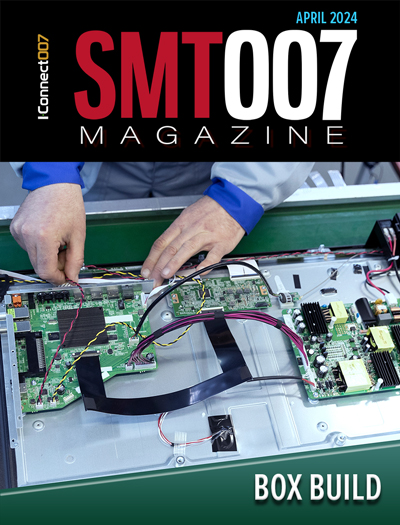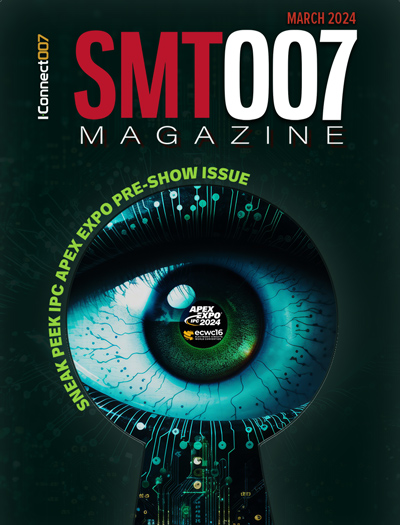-

- News
- Books
Featured Books
- smt007 Magazine
Latest Issues
Current Issue
Box Build
One trend is to add box build and final assembly to your product offering. In this issue, we explore the opportunities and risks of adding system assembly to your service portfolio.

IPC APEX EXPO 2024 Pre-show
This month’s issue devotes its pages to a comprehensive preview of the IPC APEX EXPO 2024 event. Whether your role is technical or business, if you're new-to-the-industry or seasoned veteran, you'll find value throughout this program.

Boost Your Sales
Every part of your business can be evaluated as a process, including your sales funnel. Optimizing your selling process requires a coordinated effort between marketing and sales. In this issue, industry experts in marketing and sales offer their best advice on how to boost your sales efforts.
- Articles
- Columns
Search Console
- Links
- Events
||| MENU - smt007 Magazine
Northrop Grumman: 3D Nanomaterials May Counter Gaps in Additive Supply Chain
October 22, 2020 | Andy Shaughnessy, Design007 MagazineEstimated reading time: 1 minute
The best technology is dead in the water if your domestic supply chain won’t support it. That was just one of the takeaways from Dr. Judy Dickson’s talk during the SMTA Additive Electronics TechXchange.
In her presentation, titled “Advanced PWBs: A Collaboration Between Design, Operations, and the Supply Chain,” Dickson, a senior principal systems engineer at Northrop Grumman Mission Systems, laid out the many challenges her department faces in fielding HDI advanced packaging into the next decade. Most of these challenges are related to sourcing the necessary materials in the U.S.
Dickson explained how Northrop Grumman qualifies its suppliers. The company sent sourcing assessments to over 30 suppliers to determine their capabilities and capacity gaps, and the results showed a number of gaps in the domestic supply chain.
Much of her session focused on HDI and high-density build-up (HDBU), with HD technology forming a key part of the company’s next-gen RF sensors. Dickson said that HDI allows vias down to .005” to .006” and mixed materials, while HDBU permits 0.002” vias and 0.0015” dielectrics. The interposers used for HDI and HDBU are difficult to source in the U.S.
Northrop Grumman is currently seeking new sources of materials for their next-gen interposers. And the clock is ticking; according to Dickson’s charts, the company’s demand for HDI is slated to almost triple by 2022 and double again by 2026.
The gaps in the supply chain for HDI and HDBU technologies have lead Northrop Grumman’s engineers to look to other options, including 3D-printed nanomaterials. Dickson discussed some of the work focused on this area, and she noted that research is continuing.
Like many U.S. defense firms, Northrop Grumman can develop the most cutting-edge technologies for our warfighters but finding domestic sources for necessary materials is likely to remain a constant struggle. Thanks to Dr. Dickson for shining a spotlight on this important issue.
Suggested Items
Groundbreaking Ceremony Marks the Beginning of a New Era for Newccess Industrial; The Construction of the MINGXIN Building
04/12/2024 | Newccess IndustrialOn a clear and sunny day in March, the groundbreaking ceremony for the MINGXIN Building took place in Shenzhen, China. This moment marked the official commencement of construction for a project that will reshape the semiconductor materials industry.
The Need for a Holistic Global Sustainability Standard
04/10/2024 | Michael Ford, Aegis SoftwareNo one can deny that the resources of our fragile planet are finite. The environment seems like a third party, subject to constant degradation. We’re acutely aware of the effects of pollution on our climate, and despite our “throw-away” culture, recycling and recovery of materials has remained relatively expensive, even as we use more energy just to survive.
iNEMI Publishes Four Roadmap Topics
04/04/2024 | iNEMIThe International Electronics Manufacturing Initiative (iNEMI) announces the availability of the first roadmap topics in the new iNEMI Roadmap format. Printed circuit boards, sustainable electronics, smart manufacturing, and mmWave materials and test are now available online.
Insulectro’s 'Storekeepers' Extend Their Welcome to Technology Village at IPC APEX EXPO
04/03/2024 | InsulectroInsulectro, the largest distributor of materials for use in the manufacture of PCBs and printed electronics, welcomes attendees to its TECHNOLOGY VILLAGE during this year’s IPC APEX EXPO at the Anaheim Convention Center, April 9-11, 2024.
Checking In With ICAPE Group
04/03/2024 | Nolan Johnson, I-Connect007ICAPE Group’s field application engineer Erik Pederson drills down on sustainability, supply chain resiliency, and what value engineering really looks like in this exclusive interview. Founded in 1999, European-based ICAPE Group provides 21 million printed circuit boards and over six million technical parts to manufacturers every month. With 30 PCB manufacturing partners globally and 50 partners providing a wide array of technical parts, ICAPE Group has operations in China, Taiwan, Thailand, South Korea, Vietnam, South Africa, Europe, Mexico, and the United States. The company also focuses on the value proposition for its customers.


